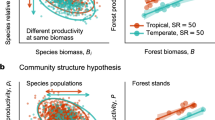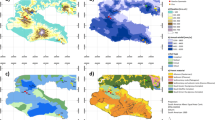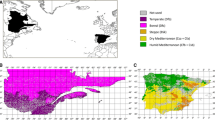Abstract
We examined effects of seasonality of climate and dominant life form (evergreen/deciduous, broad-leaf/coniferous) together with energy condition on species diversity, forest structure, forest dynamics, and productivity of forest ecosystems by comparing the patterns of changes in these ecosystem attributes along altitudinal gradients in tropical regions without seasonality and along a latitudinal gradient from tropical to temperate regions in humid East Asia. We used warmth index (temperature sum during growing season, WI) as an index of energy condition common to both altitudinal and latitudinal gradients. There were apparent differences in patterns of changes in the ecosystem attributes in relation to WI among four forest formations that were classified according to dominant life form and climatic zone (tropical/temperate). Many of the ecosystem attributes—Fisher’s alpha of species-diversity indices, maximum tree height and stem density, productivity [increment rate of aboveground biomass (AGB)], and population and biomass turnover rates—changed sharply with WI in tropical and temperate evergreen broad-leaved forests, but did not change linearly or changed only loosely with WI in temperate deciduous broad-leaved and evergreen coniferous forests. Values of these ecosystem attributes in temperate deciduous broad-leaved and evergreen coniferous forests were higher (stem density was lower) than those in tropical and temperate evergreen broad-leaved forests under colder conditions (WI below 100°C). Present results indicate that seasonality of climate and resultant change in dominant life form work to buffer the effects of energy reduction on ecosystem attributes along latitudinal gradients.






Similar content being viewed by others
References
Adams JM, Woodward FI (1989) Patterns in tree species richness as a test of the glacial extinction hypothesis. Nature 339:699–701
Aiba S, Kitayama K (1999) Structure, composition and species diversity in an altitude-substrate matrix of rain forest tree communities on Mount Kinabalu, Borneo. Plant Ecol 140:139–157
Aiba S, Kohyama T (1997) Crown architecture and life-history traits of 14 tree species in a warm-temperate rain forest: significance of spatial heterogeneity. J Ecol 85:611–624
Akashi N, Nakashizuka T (1999) Effects of bark-stripping by Sika deer (Cervus nippon) on population dynamics of a mixed forest in Japan. For Ecol Manage 113:75–82
Ando T, Chiba K, Nishimura T, Tanimoto T (1977) Temperate fir and hemlock forests in Shikoku. In: Shidei T, Kira T (eds) Primary productivity of Japanese forests (JIBP synthesis 16). University of Tokyo Press, Tokyo, pp 213–244
Brown S (1997) Estimating biomass and biomass change of tropical forests. A primer. FAO Forestry Paper 134. A Forest Resource Assessment Publication
Clark DA, Brown S, Kicklighter DW, Chambers JQ, Thomlinson JR, Ni J, Holland EA (2001) Net primary production in tropical forests: an evaluation and synthesis of existing field data. Ecol Appl 11:371–384
Cornelissen JHC (1996) An experimental comparison of leaf decomposition rates in a wide range of temperate plant species and types. J Ecol 84:573–582
Currie DJ (1991) Energy and large-scale patterns of animal- and plant-species richness. Am Nat 137:27–49
Holdridge LR (1947) Determination of world plant formations from simple climatic data. Science 105:367–368
Hutchinson GE (1959) Homage to Santa Rosalia, or why are there so many kind of animals? Am Nat 93:145–159
Ikushima I (1964) Productive structure of tree communities. In: National Park Agency of Japan (ed) Report on scientific research of Mount Ohyama in Tanzawa Mountains. Kanagawa Prefecture, Yokohama, pp 106–125
Iwasa Y, Sato K, Kakita M, Kubo T (1993) Modeling biodiversity: latitudinal gradient of forest species diversity. In: Schulze ED, Mooney HA (eds) Biodiversity and ecosystem function. Springer, Berlin Heidelberg New York, pp 433–451
Kikuzawa K (1991) A cost-benefit analysis of leaf habit and leaf longevity of trees and their geographical pattern. Am Nat 138:1250–1263
Kimura M (1960) Primary production of the warm-temperate laurel forest in the southern part of Oosumi Peninsula, Kyushu, Japan. Misc Rep Res Inst Nat Res 52–53:36–47
Kira T (1948) On the altitudinal arrangement of climatic zones in Japan (in Japanese). Kanti-Nogaku 2:142–173
Kira T (1976) Terrestrial ecosystems, ecological studies 2 (in Japanese). Kyoritu Shuppan, Tokyo
Kitayama K (1992) An altitudinal transect study of the vegetation on Mount Kinabalu, Borneo. Vegetatio 102:149–171
Kohyama T, Suzuki E, Aiba S, Seino T (1999) Functional differentiation and positive feedback enhancing plant biodiversity. In: Kato M (ed) The biology of biodiversity. Springer, Berlin Heidelberg New York Tokyo, pp 179–191
Kubota Y (1995) Effects of disturbance and size structure on the regeneration process in a sub-boreal coniferous forest, northern Japan. Ecol Res 10:135–142
Kubota Y (2000) The spatial dynamics of regeneration in a conifer/broadleaf mixed forest in northern Japan. J Veg Sci 11:633–640
Kubota Y, Hiura T, Konno Y (1994) Stand structure and growth patterns of understory trees in a coniferous forest, Taisetsuzan National Park, Japan. Ecol Res 9:333–341
Lieth H (1975) Modeling the primary productivity of the world. In: Lieth H, Whittaker RH (eds) Primary productivity of the biosphere. Springer, Berlin Heidelberg New York Tokyo, pp 237–263
Luna AC, Osumi K, Gascon AF, Lasco RD, Palijon AM, Castillio ML (1999) The community structure of a logged-over tropical rain forest in Mt. Makiling Forest Reserve, Philippines. J Trop For Sci 11:446–458
Miura M, Manabe T, Nishimura N, Yamamoto S (2001) Forest canopy and community dynamics in a temperate old-growth evergreen broad-leaved forest, south-western Japan: a 7-year study of a 4-ha plot. J Ecol 89:841–849
Nagano M (1978) Dynamics of stand development. In: Kira T, Ono Y, Hosokawa T (eds) Biological production in a warm-temperate evergreen oak forest of Japan (JIBP synthesis 18). University of Tokyo Press, Tokyo, pp 21–32
Nakagawa M, Tanaka K, Nakashizuka T, Ohkubo T, Kato T, Maeda T, Sato K, Miguchi H, Nagamasu H, Ogino K, Teo S, Hamid AA, Seng LH (2000) Impact of severe drought associated with the 1997–1998 El Nino in a tropical forest in Sarawak. J Trop Ecol 16:355–367
Nakao T (1985) Ecological studies of Abies and Tsuga forests in Kyushu, Japan. Bull Miyazaki Univ For 25:1–156
Nakashizuka T (1984) Regeneration process of climax beech (Fagus crenata) forests V. Population dynamics of beech in a regeneration process. Jpn J Ecol 34:411–420
Nakashizuka T (1991) Population dynamics of coniferous and broad-leaved trees in a Japanese temperate mixed forest. J Veg Sci 2:413–418
Nakashizuka T, Matsumoto Y (2002) Diversity and interaction in a temperate forest community. Springer, Berlin Heidelberg New York Tokyo
Niiyama K, Kassim AR, Iida S, Kimura K, Ripin A, Appanah S (2003) Regeneration of a clear-cut plot in a lowland dipterocarp forest in Pasoh Forest Reserve, Peninsular Malaysia. In: Okuda T, Manokaran N, Matsumoto Y, Niiyama K, Thomas SC, Ashton PS (eds) Pasoh: ecology of a lowland rain forest in Southeast Asia. Springer, Berlin Heidelberg New York Tokyo, pp 559–568
Ohsawa M (1995) Latitudinal comparison of altitudinal changes in forest structure, leaf-type, and species richness in humid monsoon Asia. Vegetatio 121:3–10
Phillips OL, Hall P, Gentry AH, Sawyer SA, Váquez R (1994) Dynamics and species richness of tropical rain forests. Proc Natl Acad Sci USA 91:2805–2809
Reich PB (1993) Reconciling apparent discrepancies among studies relating life span, structure and function of leaves in contrasting plant life forms and climates: ‘the blind men and the elephant retold’. Funct Ecol 7:721–725
Reich PB, Bolstad P (2001) Productivity of evergreen and deciduous temperate forests. In: Roy J, Saugier B, Mooney HA (eds) Terrestrial global productivity. Academic, San Diego, pp 245–283
Research group on forest productivity of the four universities (1960) Studies on the productivity of the forest. Part I. Essential needle-leaved forests of Hokkaido. Kokusaku Pulp, Tokyo
Runkle JR (1989) Synchrony of regeneration, gaps, and latitudinal differences in tree species diversity. Ecology 70:546–547
Suzuki E, Tsukahara J (1987) Age structure and regeneration of old growth Cryptomeria japonica forests on Yakushima Island. Bot Mag Tokyo 100:223–241
Suzuki W, Osumi K, Masaki T, Takahashi K, Daimaru H, Hoshizaki K (2002) Disturbance regimes and community structure of a riparian and an adjacent terrace stand in the Kanumazawa Riparian Research Forest, northern Japan. For Ecol Manage 157:285–301
Takahashi K (1979) Estimate of evapotranspiration based on monthly temperature and precipitation (in Japanese). Tenki 26:759–762
Takahashi K (1994) Effect of size structure, forest floor type and disturbance regime on tree species composition in a coniferous forest in Japan. J Ecol 82:769–773
Takahashi K, Yoshida K, Suzuki M, Seino T, Tani T, Tashiro N, Ishii T, Sugata S, Fujito E, Naniwa A, Kudo G, Hiura T, Kohyama T (1999) Stand biomass, net production and canopy structure in a secondary deciduous broad-leaved forest, northern Japan. Res Bull Hokkaido Univ For 56:70–85
Takyu M, Ohsawa M, Ozaki K, Ohtsuka Y, Yoshida N, Honma K, Ono M, Egusa K (1994) Community dynamics of a Cryptomeria japonica forest during 10 years in the Yakushima wilderness area, Yakushima island, southern Japan. In: Environment Agency, Nature Conservation Bureau (ed) Long term ecological studies in the Yakushima wilderness area and its surrounding areas, 1994 reports (in Japanese with English summary). Nature Conservation Society of Japan, Tokyo, pp 3–19
Takyu M, Aiba S, Kitayama K (2002) Effects of topography on tropical lower montane forests under different geological conditions on Mount Kinabalu, Borneo. Plant Ecol 159:35–49
Tanouchi H, Yamamoto S (1995) Structure and regeneration of canopy species in an old-growth evergreen broad-leaved forest in Aya district, southwestern Japan. Vegetatio 117:51–60
Tanouchi H, Sato T, Takeshita K (1994) Comparative studies on acorn and seedling dynamics of four Quercus species in an evergreen broad-leaved forest. J Plant Res 107:153–159
Thornthwaite CW (1948) An approach toward a rational classification of climate. Geogr Rev 21:633–651
Uchijima Z, Seino H (1985) Agroclimatic evaluation of net primary productivity of natural vegetations. I. Chikugo model evaluating net primary productivity. J Agr Meteorol 40:343–352
Wada N, Ribbens E (1997) Japanese maple (Acer palmatum var. matsumurae, Aceraceae) recruitment patterns:seeds, seedlings, and saplings in relation to conspecific adult neighbors. Am J Bot 84:1294–1300
Waring RH, Franklin JF (1979) Evergreen coniferous forests of the Pacific Northwest. Science 204:1380–1386
Whitmore TC (1990) An introduction to tropical rain forests. Clarendon Press, Oxford
Yamakura T, Hagiwara T, Sukardjo S, Ogawa H (1986) Aboveground biomass of tropical rain forest stands in Indonesian Borneo. Vegetatio 68:71–82
Acknowledgements
We thank Prof. T. Kohoyama and Prof. T. Nakashizuka for their valuable comments. We would also like to thank the following people who allowed us to use their plot data: Dr. H. Ida, Dr. K. Takahashi, Dr. A. C. Luna, Dr. K. Niiyama, Dr. T. Masaki, Dr. N. Akashi, Dr. M. Nakagawa, Dr. T. Manabe, Dr. Y. Kominami, Dr. Abd. Rahman Kassim, and Dr. Nur Supardi Md. Noor. Research in Pasoh Forest Reserve was supported by an NIES/FRIM/UPM Joint Research Project grant (Global Environment Research Program, Ministry of the Environment, Japan).
Author information
Authors and Affiliations
Corresponding author
Appendices
Appendix1
Appendix2
About this article
Cite this article
Takyu, M., Kubota, Y., Aiba, Si. et al. Pattern of changes in species diversity, structure and dynamics of forest ecosystems along latitudinal gradients in East Asia. Ecol Res 20, 287–296 (2005). https://doi.org/10.1007/s11284-005-0044-y
Received:
Accepted:
Published:
Issue Date:
DOI: https://doi.org/10.1007/s11284-005-0044-y




